|
part 2. |
A rather extensive collection of wonderful magic lantern slide sets |
|
|
||||||||||
| Go to: | part 1 | part 2 | part 3 | part 4 | part 5 | part 6 | part 7 | part 8 | part 9 | part 10 |
| part 11 | part 12 | part 13 | part 14 | part 15 | part 16 | part 17 | part 18 | part 19 | part 20 | |
|
|
||||||||||
| The Jackdaw of Rheims | ||
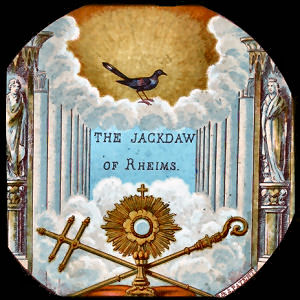 |
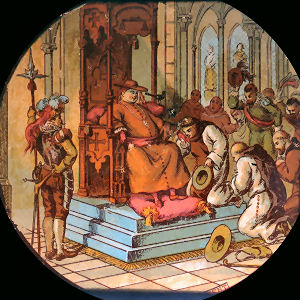 |
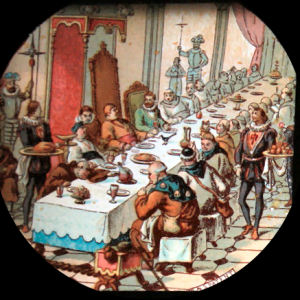 |
| 1. Title - The Jackdaw of Rheims. | 2. The Jackdaw on the Cardinal's chair. | 3. Te Jackdaw hopping about. |
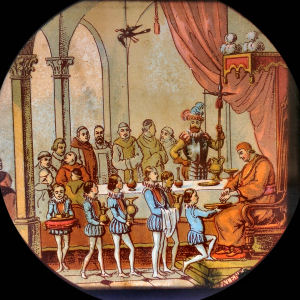 |
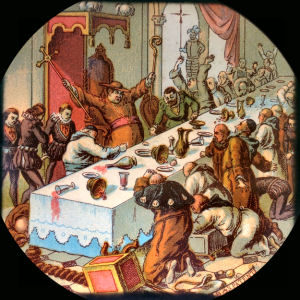 |
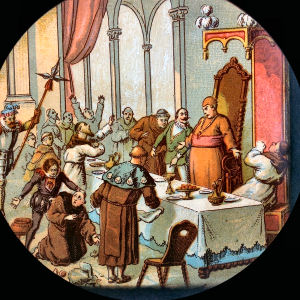 |
| 4. The little boys and the Cardinal. | 5. The loss of the ring discovered. | 6. The Cardinal's curse. |
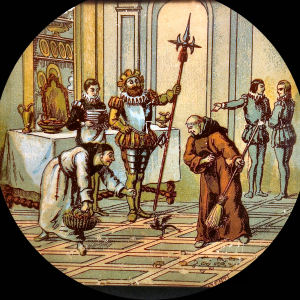 |
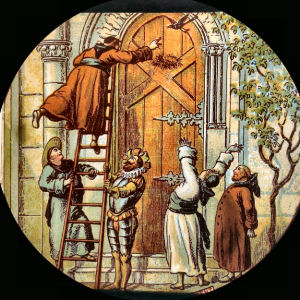 |
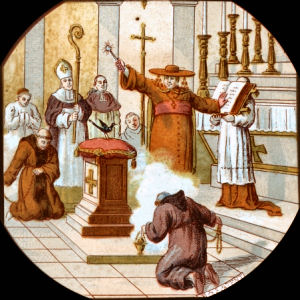 |
| 7. The little lame Jackdaw. | 8. The ring found. | 9. The curse removed. |
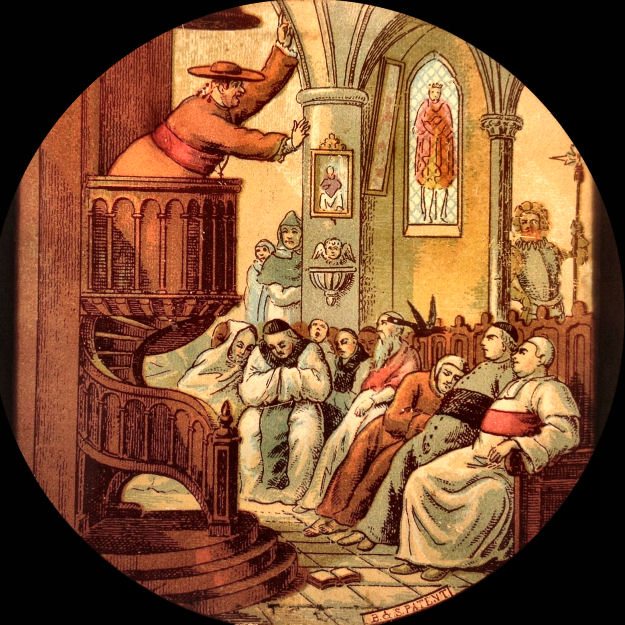 |
 |
|
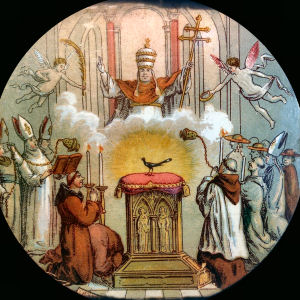 |
||
| 10. The devout Jackdaw. | 11. The death of the Jackdaw. | 12. The canonization. |
| The poem 'The
Jackdaw of Rheims' is a part of The Ingoldsby Legends, a collection of myths,
legends, ghost stories and poetry written supposedly by Thomas Ingoldsby of
Tappington Manor, actually a pen-name of an English clergyman named Richard
Harris Barham (1788–1845). Although based on real legends
and mythology they are mostly deliberately humorous parodies or pastiches of
medieval folklore and poetry. They remained popular during the 19th century but
have since become little known. The Cardinal's precious ring mysteriously vanishes during a pompous party. The Cardinal solemnly curses the thief and the jackdaw's bedraggled and ill appearance, caused by the curse, reveals him as the culprit. After the ring was found inside the jackdaw's nest, the Cardinal withdrew the curse and the jackdaw recovered. Subsequently the jackdaw became a faithful devout and, when it passed away, it was canonized. |
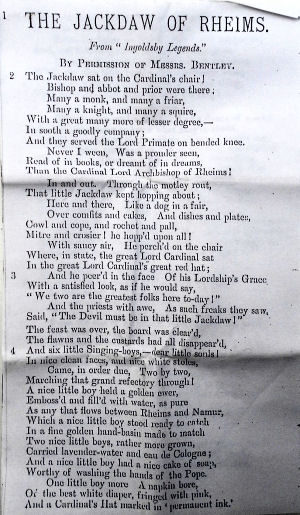 |
|
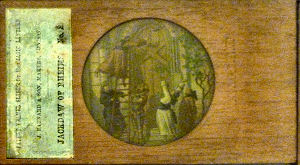 |
The 12 square slides are made by J. Barnard & Son, England. They are signed 'B&S
PATENT' at the bottom of all images. The set was also published fitted in a wooden frame (image left). |
|
|
The Jackdaw of
Rheims
This set of magic lantern slides about the story of the
famous Jackdaw was made by York & Son. |
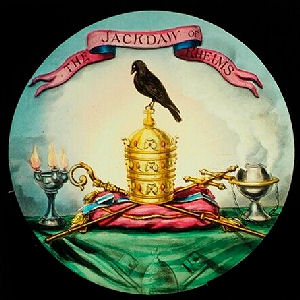 |
|
| 1. The Jackdaw of Rheims. | ||
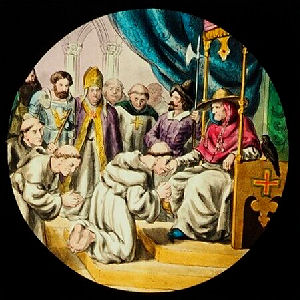 |
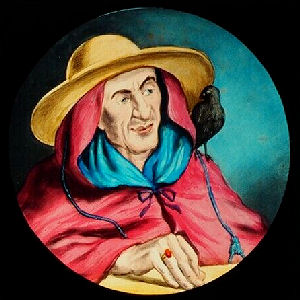 |
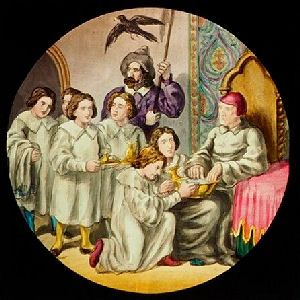 |
| 2. The Jackdaw sat on the Cardinal's chair. | 3. And he peered in the face of his Lordship's Grace. | 4. And six little singing boys, dear little souls. |
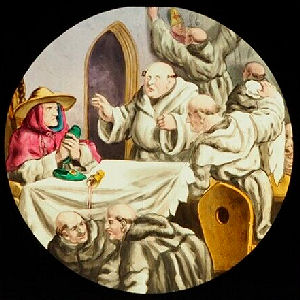 |
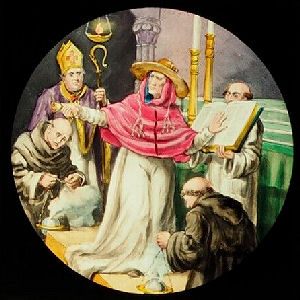 |
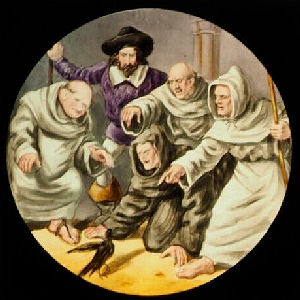 |
| 5. He peeps, and he feels in the toes and the heels. | 6. He called for his candle, his bell, and his book. | 7. They all cried 'that's him'. |
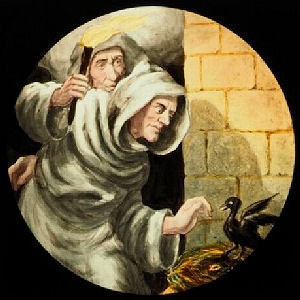 |
 |
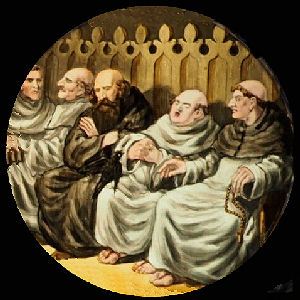 |
| 8. The first thing they saw. | 9. [repeated # 6] And off that terrible curse he took. | 10. Or slumbered in prayer time. |
 |
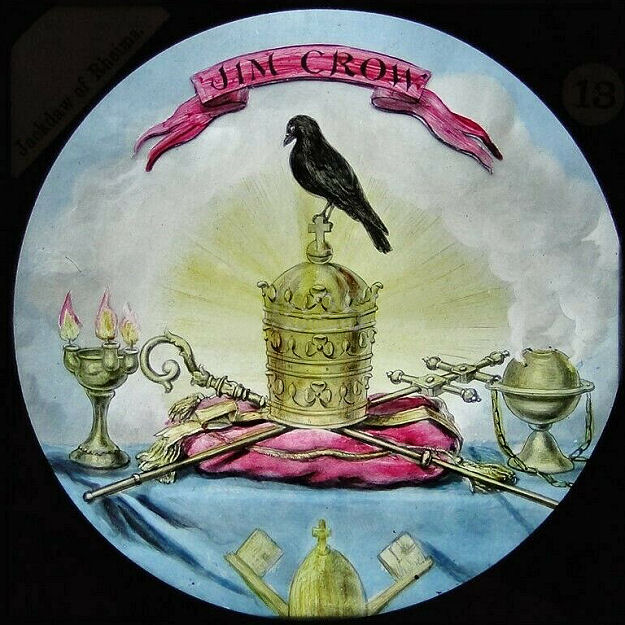 |
|
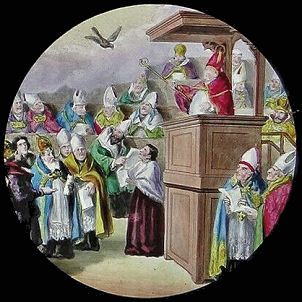 |
||
|
11. In the odour of sanctity died. |
12. The conclave determined. |
13. Saint Jim Crow. |
| These slides with the numbers 9, 10 and 11 are from another set of The Jackdaw or Rheims made by Walter Tyler. | ||
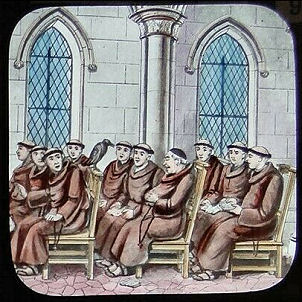 |
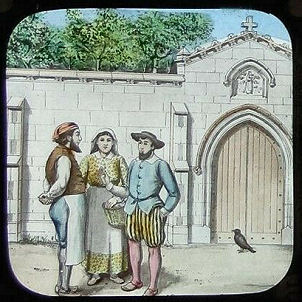 |
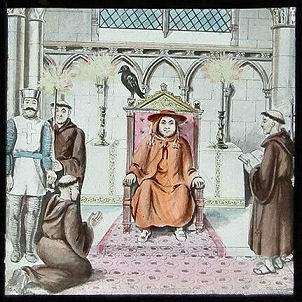 |
|
Here is another story from the Ingoldsby Legends: The little Vulgar Boy Probably made by Alfred Pumphrey, in/before 1888. 6 slides 8,2 x 8,2 cm. |
||
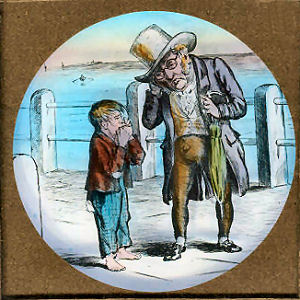 |
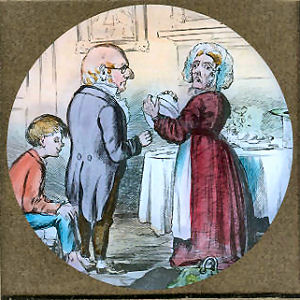 |
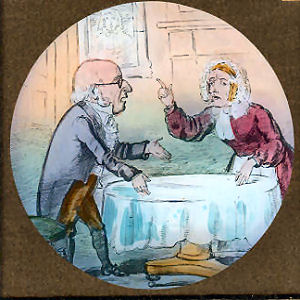 |
| 1. I havn't got no supper. | 2. I took him home. | 3. My friend not there. |
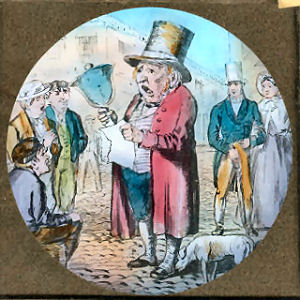 |
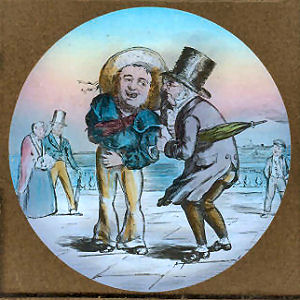 |
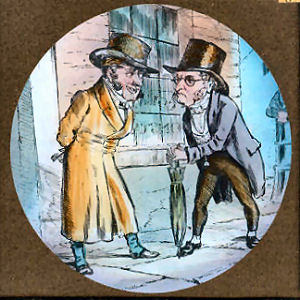 |
| 4. The Crier. | 5. Jarvis landing place. | 6. I told the constable. |
|
Misadventures at Margate, also called The
Little Vulgar Boy, is an ever popular tale of the misadventures of a
philanthropic old gentleman at Margate, as told in the Ingoldsby Legends, written supposedly by Thomas Ingoldsby of Tappington Manor, actually a
pen-name of an English clergyman named Richard Harris Barham. As a priest of the
Chapel Royal, Barham was not troubled with strenuous duties and he had ample
time to read and compose stories. The legends were first printed during 1837 as a regular series in the magazine Bentley's Miscellany and later in New Monthly Magazine. The legends were illustrated by John Leech, George Cruikshank (The Bottle), and Sir John Tenniel. This is how the story starts: |
||
|
'Twas in Margate last July, I walk'd upon the pier, I saw a little vulgar Boy -- I said, 'What make you here? The gloom upon your youthful cheek speaks anything but joy;' Again I said, 'What make you here, you little vulgar Boy?' |
He frown'd, that little vulgar Boy,-- he deem'd I meant to
scoff -- And when the little heart is big, a little 'sets it off;' He put his finger in his mouth, his little bosom rose,-- He had no little handkerchief to wipe his little nose! |
|
Bob Sawyer's Party A set of eight square magic lantern slides made by York and Son, England. |
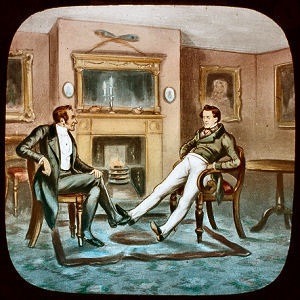 |
 |
| 1. Bob Sawyer and Ben Allen at home. | 2. Mr Sawyer, Mrs Raddle wants to speak to you. | |
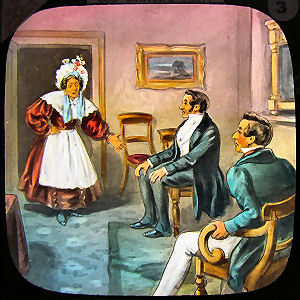 |
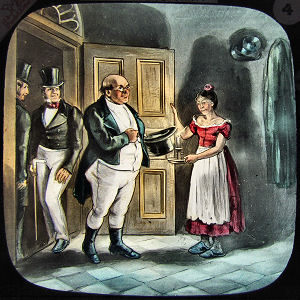 |
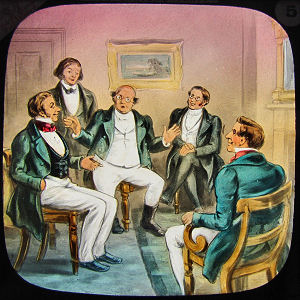 |
| 3. Mrs Raddle raises her voice to its highest pitch. | 4. Does Mr Sawyer live here? said Mr Pickwick. | 5. That's the most extraordinary case I ever heard of. |
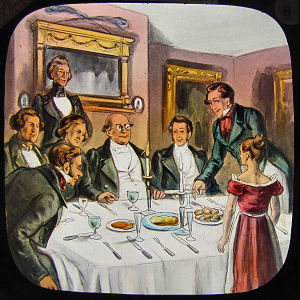 |
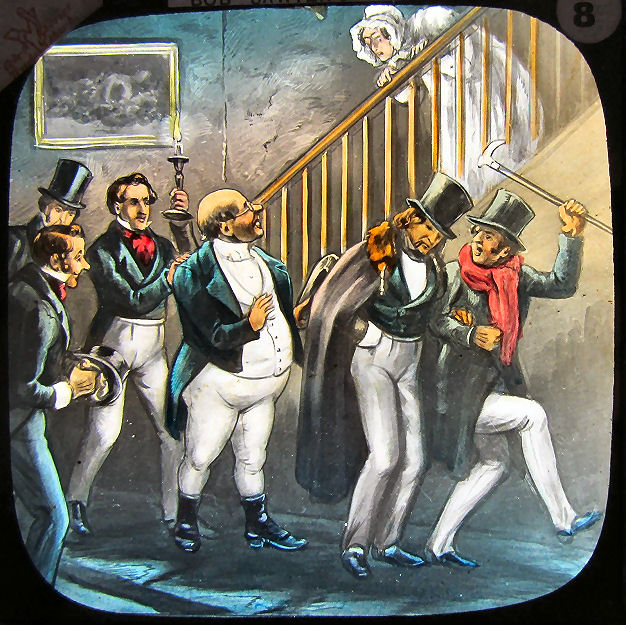 |
|
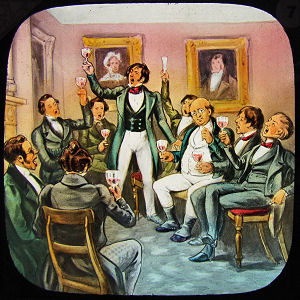 |
||
| 6. The supper was not easily got ready. | 7. The King, God bless him. | 8. Get along with you, you old wretch! |
| Bob Sawyer's
Party is Chapter 32 of Charles Dickens' first novel The Pickwick Papers (1836). It describes 'far more
fully than the court newsman ever did, a bachelor's party given by Mr. Bob
Sawyer at his lodgings in the Borough.' Living in a dismal, impoverished neighbourhood, Bob Sawyer is harangued by his vituperative landlady, Mrs. Raddle, because he cannot pay the rent. The Pickwickians arrive at his party, to which a number of medical students have been invited. One named Jack Hopkins relates some lugubrious anecdotes about medical curiosities. The party is a disaster. An angry dispute arises at cards. The dinner is a failure. Sawyer cannot obtain hot water to make drinks. A long, tedious story is told in which the point has been forgotten. Two men are ready to duel. There is no harmony to the singing. And Mrs. Raddle enters the room screaming, which puts an end to the party. |
||
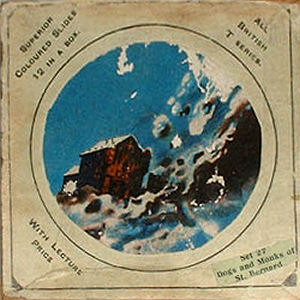 |
The Dogs
and Monks of St Bernard This set of magic lantern slides made by Theobald & Co., England, features the story of the rescue of a little boy and his mother who has become lost on the mountains. Luckily they are near the famous Monastery of St Bernard and over the 12 slides we see how the monks send out one of their dogs to rescue the child, then the mother. All is well in the end. And as many Victorians were of the temperance persuasion, there is not a barrel of brandy in sight! This is set 27 of All British T Series (with Printed Readings). |
|
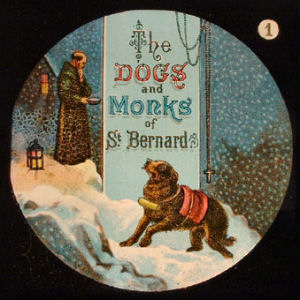 |
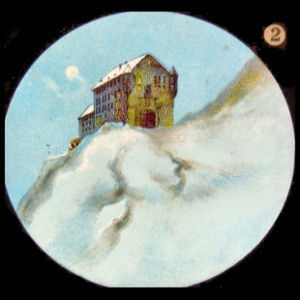 |
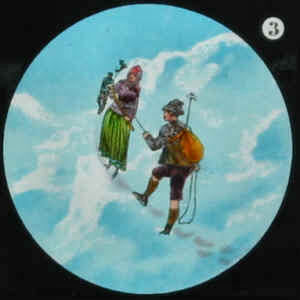 |
| 1. Title slide. | 2. The wonderful Hospice on the mountain of snow. | 3. A party of tourists descending the mountains. |
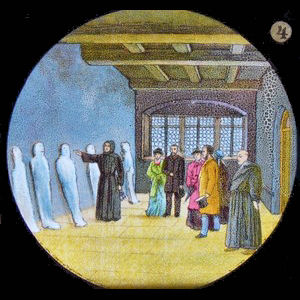 |
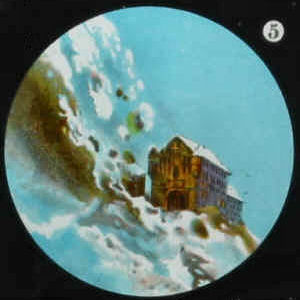 |
 |
| 4. Bodies found frozen and dead in the snow. | 5. The Effects of an Avalanche. | 6. Setting out on a bitterly cold winter's night. |
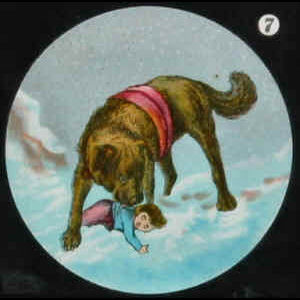 |
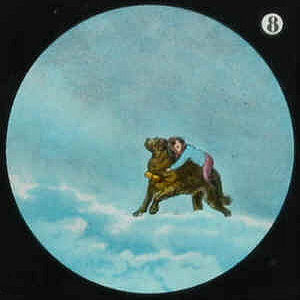 |
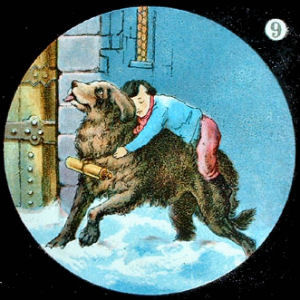 |
| 7. It appears to be a little child. | 8. At last clambered on its broad rough back. | 9. Arrived at the door he barked loudly. |
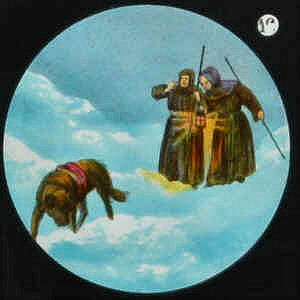 |
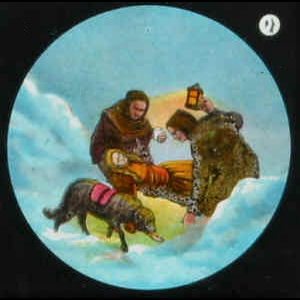 |
 |
| 10. He stops at a mound of snow and barks and paws away. | 11. The figure of a peasant woman is soon brought to light. | 12. Mother and child are united once again. |
 |
Also published as a set of
four long glass slides each containing three images. |
|
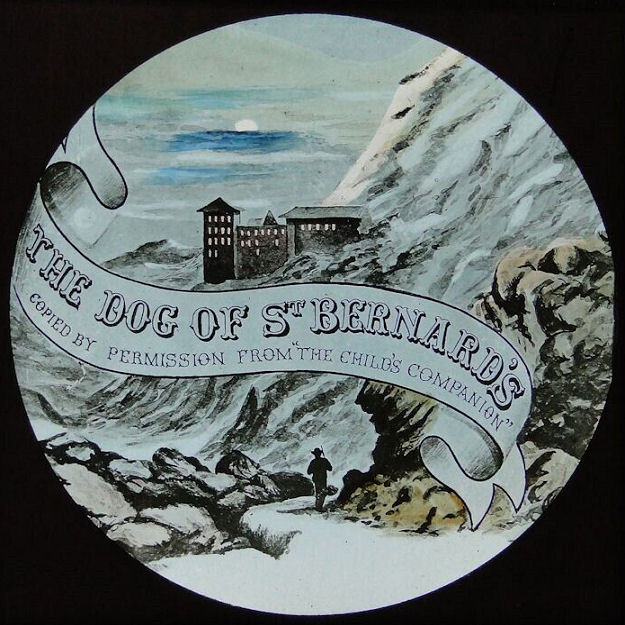 |
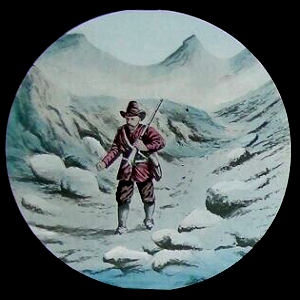 |
|
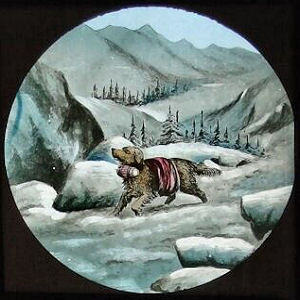 |
||
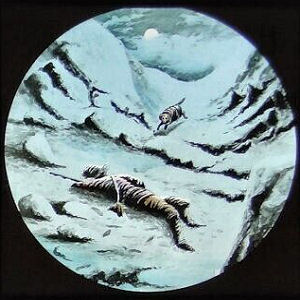 |
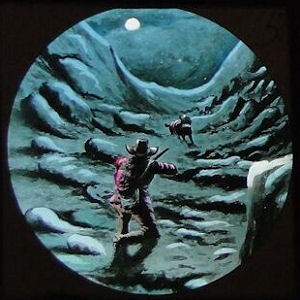 |
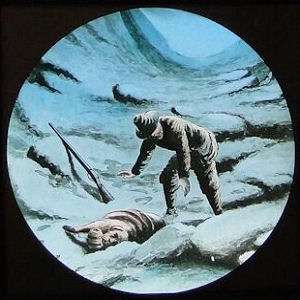 |
 |
The Dog of St Bernhard's
Although the title of this slide series is very similar to that of the previous series, the story is very different. A hunter mistakenly shoots a dog that is about to save a victim. He has some explaining to do when he arrives at the monastery. A series of probably 7 square magic lantern slides made by an unknown manufacturer and copied by permission from '"The Child's Companion". |
|
An Elegy written in a Country Churchyard, by Thomas Gray |
|
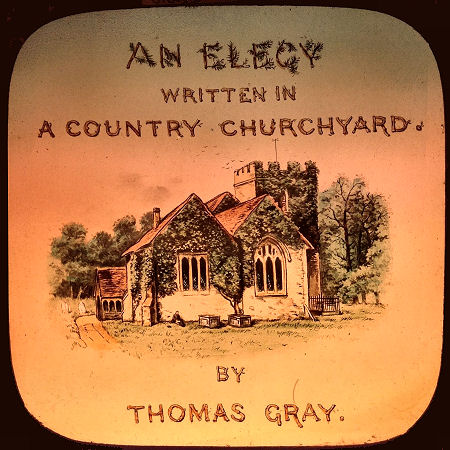 |
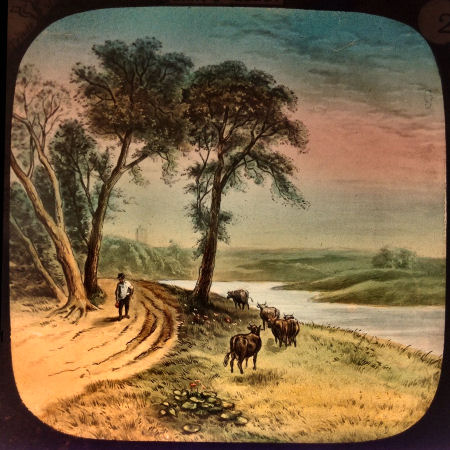 |
| 1. Title, with picture of Stoke Pogis Church. | 2. The curfew tolls the knell of parting day. |
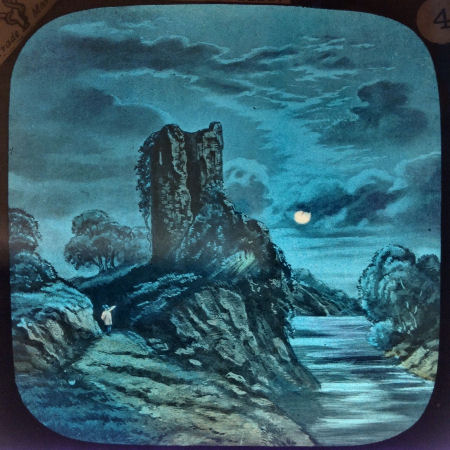 |
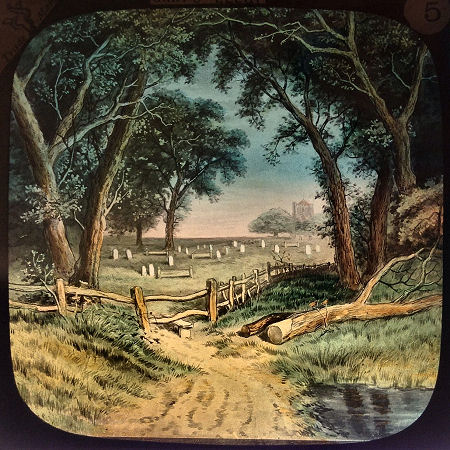 |
| 4. The moping owl does to the moon complain. | 5. Beneath those rugged elms, that yew tree's shade. |
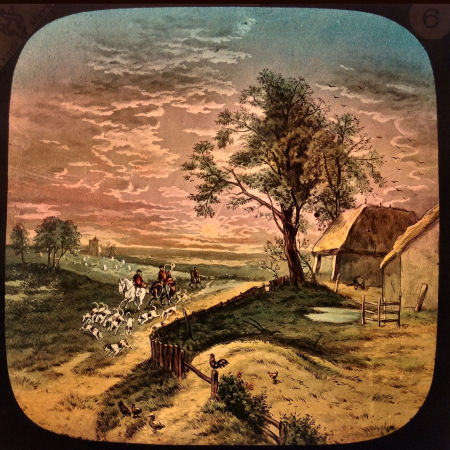 |
 |
| 6. The breezy call of incense breathing morn. | 7. For them no more the blazing hearth shall burn. |
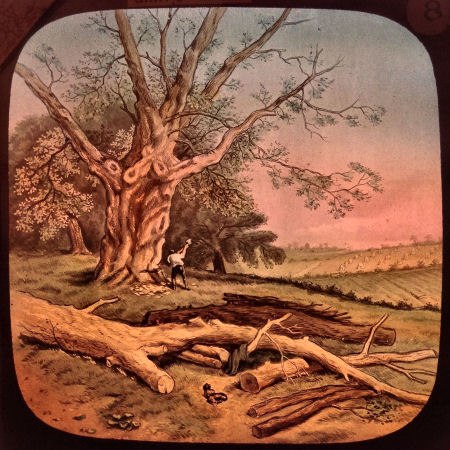 |
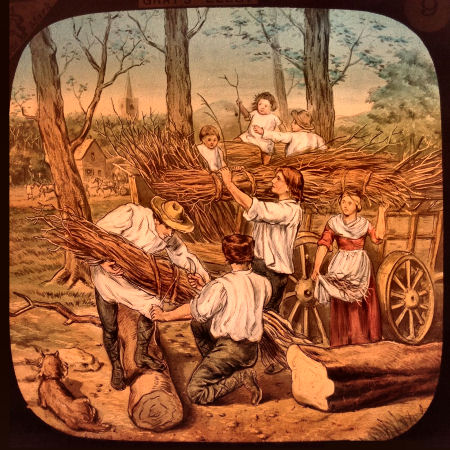 |
| 8. How bowed the woods beneath their sturdy stroke. | 9. Let not ambition mock their useful toil. |
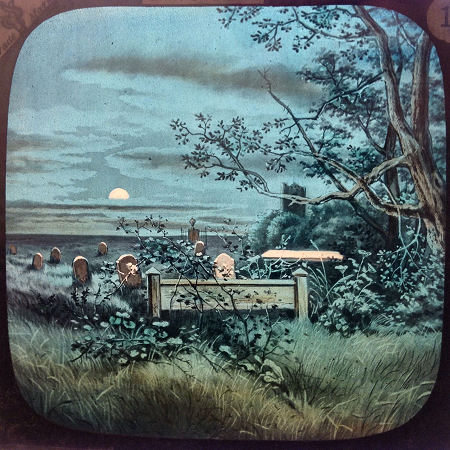 |
 |
| 10. The paths of Glory lead but to the grave. | 20. Here rests his head upon the lap of earth. |
| Though this wonderful set of slides is not complete - the complete set consists of no less than 20 slides - the pictures are too beautiful to let them unpublished at this site. The set is made by York & Son, England, after the best known poem of the English poet Thomas Gray (1751). Probably Gray wrote the poem in the churchyard of Stoke Poges in Buckinghamshire, where Gray is buried himself beside his mother. The poem is still one of the most popular and most cited poems in England. | |
More...... |
|
| |
©1997-2025 'de Luikerwaal' All rights reserved. Last update: 14-02-2025. |
|